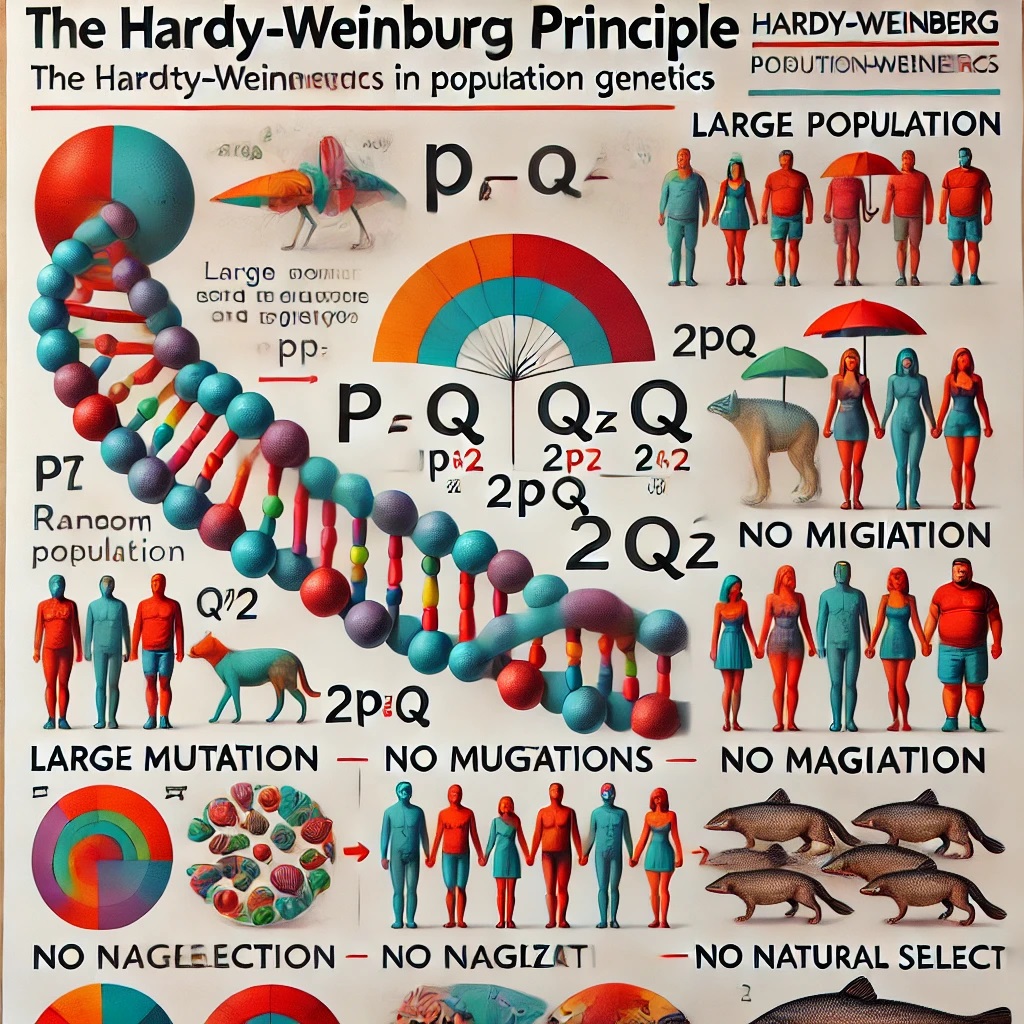Introduction
Introduce the Hardy-Weinberg Principle as a core concept in population genetics. Explain its importance in understanding how alleles (different forms of a gene) and genotypes (gene combinations) are distributed within a population. Mention that this principle is key for predicting genetic variation and evolutionary changes under stable conditions.

Key Points:
- Introduce the field of population genetics.
- Define Hardy-Weinberg Principle as a tool for measuring genetic equilibrium.
- Briefly state the importance of this principle for understanding evolutionary processes.
History and Development of the Hardy-Weinberg Principle
Discuss the origins of the principle, named after mathematician G.H. Hardy and physician Wilhelm Weinberg, who independently formulated it in 1908. Explain that their work aimed to address misconceptions about genetic inheritance and variation over generations. The principle has since become a foundational model in evolutionary biology.
Key Points:
- Introduce G.H. Hardy and Wilhelm Weinberg.
- Discuss the motivation behind the principle.
- Explain how this principle corrected earlier misunderstandings in genetics.
Assumptions of the Hardy-Weinberg Principle
Outline the conditions under which the Hardy-Weinberg Principle applies, explaining that these conditions represent an “ideal” population. Describe each assumption and its significance:
- Large Population Size: Genetic drift has negligible effects in large populations, so allele frequencies remain stable.
- Random Mating: All individuals mate randomly without preference, ensuring equal chances of passing on alleles.
- No Mutation: Mutations are absent or rare, so allele frequencies do not change due to genetic alterations.
- No Migration: No individuals move in or out of the population, preventing gene flow from altering allele frequencies.
- No Natural Selection: All genotypes have equal reproductive success, so natural selection does not favor one allele over another.
Key Points:
- Explain each assumption and why it is necessary for genetic stability.
- Emphasize that these conditions are rarely met in nature, but useful for theoretical models.
The Hardy-Weinberg Equation
Introduce the Hardy-Weinberg equation, which calculates the frequencies of alleles and genotypes in a population. Provide the equations and explain each part:
- Allele Frequency: p+q=1
- Genotype Frequency: p2+2pq+q2=1
Explain what each variable represents: ppp as the frequency of the dominant allele and qqq as the frequency of the recessive allele. Discuss how this equation is used to calculate the proportion of homozygous dominant, heterozygous, and homozygous recessive individuals in the population.
Key Points:
- Define ppp and qqq and how they relate to allele frequencies.
- Discuss the genotype frequency formula and its interpretation.
- Explain how these equations provide insight into population genetics.
Example Calculations Using Hardy-Weinberg Principle
Provide a simple example to demonstrate how to use the Hardy-Weinberg equation. For example, assume a population with a dominant allele frequency of p=0.6p = 0.6p=0.6. Calculate the expected frequencies of each genotype: homozygous dominant (AA), heterozygous (Aa), and homozygous recessive (aa).
Key Points:
- Provide step-by-step calculations.
- Show the interpretation of each genotype frequency result.
- Use realistic numbers to clarify the process.
Applications of the Hardy-Weinberg Principle
Discuss the practical uses of the Hardy-Weinberg Principle in genetics and evolutionary biology:
- Genetic Counseling and Public Health: Predicting carrier rates of genetic diseases within populations, useful in genetic counseling.
- Evolutionary Studies: Tracking changes in allele frequencies over generations to infer evolutionary pressures.
- Population Structure Studies: Assessing the genetic diversity and structure of populations, important for conservation biology.
- Genetic Drift and Selection Studies: Understanding the effects of genetic drift, natural selection, and gene flow on genetic diversity.
Key Points:
- Highlight specific fields (public health, evolution, conservation).
- Use examples to illustrate each application.
- Explain how Hardy-Weinberg predictions help in real-world genetic research.
Factors That Disturb Hardy-Weinberg Equilibrium
Explore factors that prevent real populations from meeting Hardy-Weinberg equilibrium:
- Genetic Drift: Small populations can experience significant fluctuations in allele frequencies by chance.
- Non-Random Mating: Assortative mating, inbreeding, or sexual selection can alter genotype frequencies.
- Mutations: New alleles can be introduced, changing allele frequencies.
- Gene Flow: Migration introduces or removes alleles from a population.
- Natural Selection: Differential reproductive success of genotypes can lead to changes in allele frequencies over time.
Key Points:
- Explain each factor and its effect on allele frequencies.
- Discuss real-life examples of these factors in action.
- Emphasize how these factors lead to evolutionary changes.
Limitations and Criticisms of the Hardy-Weinberg Principle
Discuss limitations of the Hardy-Weinberg Principle in biological contexts. Explain why it is rarely seen in real populations due to idealized assumptions. Discuss criticisms of its application in complex populations, especially when non-genetic factors play significant roles in evolution.
Key Points:
- Address the limitations of applying Hardy-Weinberg to natural populations.
- Mention the challenge of non-genetic factors (environmental effects).
- Discuss its value as a theoretical model rather than a strict representation of real-world genetics.
Modern Applications and Extensions of the Hardy-Weinberg Principle
Describe how modern population genetics has built upon Hardy-Weinberg principles. Discuss how modern technologies, like genome sequencing, allow researchers to test and extend Hardy-Weinberg concepts. Explain how the principle has evolved to address complex genetic interactions and gene-environment interactions.
Key Points:
- Mention the role of bioinformatics in extending Hardy-Weinberg studies.
- Highlight examples of how geneticists use Hardy-Weinberg in modern evolutionary studies.
- Discuss extensions like polygenic traits and how they relate to Hardy-Weinberg.
Conclusion
Summarize the main points of the Hardy-Weinberg Principle. Emphasize its importance as a foundational concept in understanding genetic variation and stability. Conclude by noting how the principle serves as a baseline for studying evolutionary processes and the factors that drive genetic change.
Key Points:
- Reiterate the importance of Hardy-Weinberg as a foundation in genetics.
- Emphasize its role in evolutionary biology and population studies.
- Briefly mention ongoing relevance in modern genetics research.
Questions and Answers about the Hardy-Weinberg Principle
What is the Hardy-Weinberg Principle?
- The Hardy-Weinberg Principle is a fundamental concept in population genetics that describes how allele and genotype frequencies remain constant in a population across generations, provided certain conditions are met. It serves as a model for genetic equilibrium.
What conditions must be met for a population to be in Hardy-Weinberg equilibrium?
- Five conditions are required: (1) a large population size, (2) random mating, (3) no mutations, (4) no migration (gene flow), and (5) no natural selection. If these conditions hold, the genetic variation within the population should remain stable.
Why is the Hardy-Weinberg Principle important in biology?
- The principle provides a mathematical baseline for studying genetic changes in populations. By comparing real-world data to Hardy-Weinberg predictions, scientists can detect evolutionary forces like natural selection, mutation, and gene flow.
What is the Hardy-Weinberg equation?
- The equation consists of two main parts: p+q=1p + q = 1p+q=1, which calculates allele frequencies, and p2+2pq+q2=1p^2 + 2pq + q^2 = 1p2+2pq+q2=1, which calculates genotype frequencies. Here, ppp represents the dominant allele frequency and qqq represents the recessive allele frequency.
How can we use the Hardy-Weinberg Principle to predict genetic variation?
- By knowing the allele frequencies, we can use the Hardy-Weinberg equation to calculate expected genotype frequencies for a population in genetic equilibrium. This helps predict the proportions of homozygous dominant, heterozygous, and homozygous recessive individuals.
What happens if a population is not in Hardy-Weinberg equilibrium?
- If a population’s genetic frequencies deviate from Hardy-Weinberg expectations, it suggests that one or more evolutionary forces are at play, such as natural selection, mutation, gene flow, or genetic drift.
How does the Hardy-Weinberg Principle help in understanding evolution?
- The principle acts as a “null hypothesis” for genetic stability. When populations deviate from Hardy-Weinberg equilibrium, it indicates that evolution may be occurring due to changes in allele frequencies caused by natural selection, mutation, or other factors.
What is genetic drift, and how does it affect Hardy-Weinberg equilibrium?
- Genetic drift is a random change in allele frequencies that occurs in small populations. It disrupts Hardy-Weinberg equilibrium by introducing chance-based fluctuations in allele frequencies, often leading to a loss of genetic diversity.
Can the Hardy-Weinberg Principle be applied to all genes?
- It applies best to single-gene traits with two alleles in large populations. For traits influenced by multiple genes or with more complex inheritance patterns, the Hardy-Weinberg Principle may need adjustments or extensions.
What are some practical applications of the Hardy-Weinberg Principle?
- It is used in genetic counseling to estimate carrier frequencies for genetic disorders, in conservation biology to assess genetic diversity in populations, and in evolutionary studies to understand the impact of selective pressures on allele frequencies over time.






